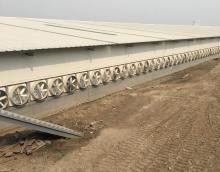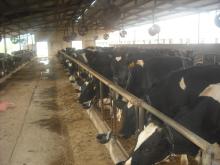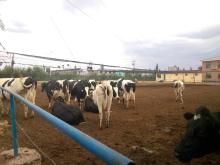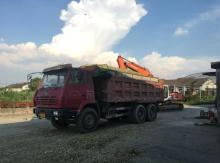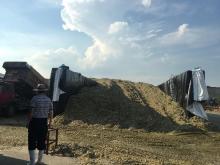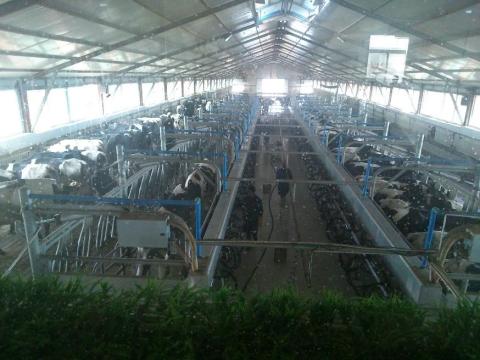Learnings from Animal Raising Zones -- taking Chinese dairy cattle raising zone as an example
By Chong Wang 1 , Jianxin Liu 2, Harinder P.S. Makkar3 , Jinyong Yang4
1College of Animal Science and Technology/ College of Veterinary Medicine, Zhejiang University
2College of Animal Sciences, Zhejiang University, Hangzhou, China
3International Consultant, Sustainable Bioeconomy, Vienna, Austria
4Zhejiang provincial animal husbandry technology promotion and monitoring station of breeding livestock and poultry, Hangzhou, China
Introduction
In recent times, with the strengthening of urban-rural linkages in China, the animal husbandry landscape and commercial structure have changed. These changes have specifically manifested in the emergence of large-scale farm communities in animal husbandry. There has been a shift from smallholder farms to large community-based farms in the form of animal raising zones (ARZs). This development is of great significance in improving production efficiency, reducing animal infectious diseases, and ensuring the animal product quality and safety. The establishment of ARZs is relatively a new concept, and its development is still in its infancy. The ARZs can apply the advanced science and technology to animal husbandry and promote the use of innovative and improved animal husbandry and breeding technologies. However, most potential operators have little experience of raising animals in the ARZs. We have analysed some ARZs. It is hoped that the information analysed and discussed on this new model of animal husbandry practice would guide the potential as well as existing operators to realise the maximum gains from rearing animals in the ARZs.
Advantages of Animal Raising Zones
An ARZ refers to an area that is suitable for livestock rearing, where multiple farmers carry out specialized and standardized production and implement unified management, disease prevention and pollution control practices in accordance with the requirements of the intensive livestock farming.
Traditionally, the farmers feed and manage animals on their own. The traditional management is based on the experiences accumulated by the farmers, most of which have not been scientifically tested and proven, resulting in low animal production and poor adoption of new and improved technologies. As an example, when livestock are sick, there is hardly any diagnosis of the causes based on sound scientific knowledge. Based on symptoms, drugs are given, most of the times improper ones. As a result, prevention of the spread of epidemic diseases becomes difficult. In ARZs, livestock diseases can be managed by proper diagnosis of the disease and giving right medicines. This helps in preventing spread of diseases.
China's dairy industry started relatively late, with outdated farming methods. Small-scale farmers are still the main producers of a large quantity of fresh milk. The system employs extensive feeding management and poor hygienic conditions that compromise milk quality and safety. To overcome these constraints the dairy cattle ARZs have sprung up, to support the new growth targets of the dairy farming in China, and to gradually replace the original small-scale farming. To produce high-quality dairy products at a lower cost, use of a large-scale balanced feeding and implementation of other scientific management practices are vital (Mi and Xu, 2011). The ARZs are large-scale farms, usually based on asset ownership and management rights of participation of smallholder farmers (Wang et al., 2014a). A dairy cattle ARZ is also known as a milk station. The community provides the farmers with the infrastructure, equipment and living facilities for animals including the site and production equipment required for dairy production. Figures 1 and 2 presents outside and inside views of an ARZ. The milking facilities are operated and managed by the ARZ management. The ARZ and farmers are unified and share the benefits, though are independent. The large-scale farms have their own infrastructure, living facilities and cows, but the feeding, management and milking of cows are managed in a unified way.
Figure 1 : Outside view of an ARZ (Photo credit: Dr. Wang)
With the rapid growth of animal husbandry industry and increase in feeding, breeding and rearing costs, farmers are facing increasing competition. The ARZ is an effective way to enhance competitiveness and carry out scientific feeding and management practices to improve productivity, decrease production cost and ensure product quality and safety.
Site selection and construction
For ARZ construction, the concept used for setting up of an industrial zone or industrial park can be borrowed; and the environmental, economic and social development factors of various sites can be considered. In an area suitable for livestock rearing, the animals from the scattered farms (households) can be concentrated in one place. Through strengthening infrastructure, improving supporting services, standardizing management systems, improving production technology; and through unified planning, branding, management and pollution control, large-scale and standardized production could be achieved.
When building an ARZ, the site selection should consider long-term development needs. First, environmental protection should be considered to ensure the ecological safety of soil, air, water and other environmental factors around the zone. Second, the site should be far away from the scenic spots, lakes and other water sources such as springs, rivers and boreholes. The distance should be more than 500 meters from railway tracks, highways, towns, residential areas, and other public places. In addition, there should be a distance of at least 3 km between the ARZ and slaughterhouses, processing plants and livestock trading places to prevent the invasion and spread of epidemic diseases (Ulijiang bahdawuleti, 2017). Thirdly, the site should conform to the local development planning and development requirements and not be built in places that are suitable for water storage around cities that may be needed to supply water to the cities when they expand in the future. At the same time, it is necessary to ensure good transportation network to the site. Lastly, the ARZ should be built in a place with sufficient sunshine and access to clean and adequate water supply. The place should be warm in winter and cool in summer.
The construction of ARZ shall meet the requirements set for the animal epidemic prevention. The overall building layout should be divided into at least three parts: management area, production area, and waste treatment area. A separate site for milking parlor is also suggested. The management area, milking parlor and production area shall be in the upwind direction, and the waste disposal area should be in the downwind direction.
Cooperation mode of ARZ
Enterprise driven
A leading animal husbandry enterprise directly invests and absorbs farmers to participate in the establishment of ARZ through stock ownership. Independent accounting is implemented; and shareholders not participating in the daily management are paid dividends according to the share they hold. They can also directly participate in production under the unified management, and get wages as per the production responsibility and the year-end dividend as per their share. Through the establishment of a community management committee or cooperative organization, employment of technical consultants is undertaken. “The ARZ model is enterprise driven with farmers being shareholders". It enjoys the advantages of economy of scale having advanced technology and management in place.
Collective investment driven
The concept of collective economy in which the collective money from a group of persons is invested in a unified manner for provision of site, planning and design, water-electricity-road construction, and for the farmers to build their own farms in the zone. The government departments can guide and help the ARZ to set up a management committee, to carry out specific planning and implement the construction site, so as to meet the unified feeding, disease prevention and pollution control requirements.
Farmers' association
Government departments organize and guide farmers to operate the ARZ by self-management and self-service. Although the farmers’ association is called ARZ, there is no specific legal entity and unified organizational title. Because of this daily maintenance of infrastructure and records keeping are poor. Overall sound management of the system is missing, resulting in resourcing of poor quality and counterfeit products including feed, vaccines, veterinary drugs and other inputs. Corruption in procurement of inputs is a possibility.
Farmers' association is composed of small-scale and decentralized farmers. Because each farmer has no unified standard and understanding, they often choose technical personnel and technical operational procedures according to their understanding.
The protocols and regulatory requirements for disease prevention and control are not strictly followed. As a result, people and vehicles enter and leave the ARZ at will, without inspection and disinfection. The external infectious diseases can easily enter the ARZ. Also, the pathogens can easily flow out of the ARZ, resulting in the spread of epidemics (Wang Yonglai, 2018).
Production management
Farm organization
Standardized management should be implemented in the ARZ. It is suggested to establish associations or cooperative organizations to implement unified approaches for planning and construction; transparent and auditable practices for procurement and technical services, and other good practices that do not harm environment. It is vital to establish and improve the management system and the operational protocols and procedures, including proper record keeping and standardized production of quality products, to meet the existing stiff competition.
Personnel management
The ARZs should have professional technicians, who are responsible for the feeding management, disease prevention and control, sanitary disinfection, veterinary drug management, among others. The technicians also need to formulate a standardized production management system and scientific feeding mode, and constantly adjust the feeding according to the nutrient requirements. In the daily management of ARZ, a good recording system is essential to proactively solve the technical problems encountered in the animal rearing process. The movement of personnel must be strictly controlled. The staff should be in good health and must undergo regular health examination. At the same time, the ARZ should be responsible for training of staff.
Management system
Following management systems should be established in the ARZ.
- Personnel and goods management system,
- Livestock entry and exit management system,
- Veterinary medicine purchase and use management system,
- Feed processing and use management system,
- Feed additive use management system,
- Disease prevention and control system,
- Disinfection system,
- Farm effluent treatment system,
- Safe dead-animal disposal system,
- Disease monitoring and reporting system,
- Personnel training system,
- Product sales system, and
- Daily operation system
The ARZ should be equipped with a dedicated person responsible for the management of archives and production records. It includes feed sources, feed consumption, milk yield, morbidity, mortality and causes of death, waste treatment and disposal, laboratory inspection, medication, immunization, sales records of animal, among others.
Production management
Investment and procurement
The ARZ usually adopts the method of collective procurement. This procurement includes feed and milking equipment. Because of the huge demand for feed, it is much cheaper to buy at wholesale price than to buy feed by individual dairy farmers. This reduces the feed cost and ensures the feed quality. The unified approach of purchasing milking equipment and other inputs also reduces their costs and increases efficiency of personnel time. Due to presence of a large number of dairy farms in cattle ARZ, the unified approach increases profitability, decreases carbon footprint and ensures milk quality and safety.
Feeding and milking management
Dairy cattle farmers keep their cows into dairy cattle ARZ for unified rearing. Large scale rearing can improve efficiency of utilization of resources.
Figure 2: Stables, outside area for cows and calves' area (Photo credit: Dr. Wang)
The feed (Figure 3) used must conform to the regulations and standards, and different rations and their amounts need to be offered to animals depending on their physiological stage and production yield.
Figure 3. Feeds (silage) and feed equipment (machine to make silage, truck for transportation and silo. (Photo credit: Dr. Wang)
Mechanization greatly reduces the time and labor costs of milking and feed distribution. The use of advanced milking equipment allows dairy farming community to milk 420-560 cows per hour. This greatly reduces the milking time and the operating costs. Advanced milking equipment not only greatly improve the working efficiency, but also reduces the bacterial load in milk and improve milk quality. The milk can be directly taken to the storage tanks through pipes for cooling, which helps in maintaining freshness and quality. The milk yielded by a cow can be recorded. By analyzing the milk production of each cow, the technicians in ARZ can understand the cow health, and can feed the rations as per the milk yield. The milk sample of a cow can also be sampled and analyzed for dairy herd improvement. Based on the data, dynamic adjustment of dairy farming is carried out.
It is important to note that the efficiency of dairy farms in a ARZ depends on the effectiveness of the management.
Milk quality management
In the ARZs, cows are raised in accordance with the feeding standards. The quality drugs in appropriate doses are used, and their strict withdrawal time is implemented to produce high-quality and safe milk. Many ARZs have built milking parlors, equipped with advanced milking machinery and cold storage equipment, and implemented centralized milking and cold chain storage, effectively putting an end to the adulteration of raw milk (Figure 4).
Figure 4.1. Milking parlour (Photo credit: Dr. Wang)
Figure 4.2: Milk tank (Photo credit: Dr Wang)
Furthermore, they have maintained good hygiene during milking and in the farm. Highly modernized ARZs have special personnel to strictly monitor the quality of fresh milk, formulate and practice quality inspection standards, good farm management practices and protocols, and inspect fresh milk as per schedule. These efforts not only provide quality fresh and safe milk, but also safeguard ARZs own interests in terms of sustainability, and fair trade.
Disease prevention
It is better to raise the same breed of animals and implement the same feeding standards and disease prevention procedures in an ARZ. A sound animal disease prevention system and immunization procedures can effectively control the occurrence and spread of diseases, reduce economic losses, reduce mortality rate, and increase income. At the same time, product quality and food safety can be ensured. The ARZ should adhere to the principle of ‘prevention is better than cure’. Under the guidance of the local animal husbandry and veterinary administrative department, the system and measures of immunization procedures, sanitary disinfection and disease prevention should be formulated according to the legal provisions and regulations, and used in the ARZs.
Waste Treatment and Pollution Prevention
During the construction of an ARZ, the treatment and discharge of feces in each unit and the whole community should be considered, and feces must not be stacked and discharged at will. Installation of biogas fermenters is suggested to process manure. This will generate energy and decrease carbon footprint of the dairy farms in the ARZ. The residue could be used as manure or sold as farmland fertilizer. A wastewater treatment plant can be installed for all the dairy farms in an ARZ.
Profits and Dividends
Profit
The main income of the ARZ is from the sales of milk. Generally, the mode of unified milk collection and sales is adopted. The government promotes the establishment of operative relationships between dairy processing enterprises and the dairy units in ARZ; and negotiates the purchase price of raw milk through cooperative organizations to protect the interests of dairy farmers. Generally the milk production and benefits in the large-scale dairy farms are higher than those in the ARZs (Wang et al., 2014a; Wang et al., 2014b). However, the cost of running dairy units is lower in the ARZs than that of the large-scale dairy farms. If the technology, management and equipment can be further improved, the ARZs have a great development potential. In addition, there are also ARZs that have shares in dairy processing enterprises and establish close cooperation with them. The ARZ members also benefit from the value addition of their milk-to-milk products. The ARZ and dairy processing enterprises share common interests of producing quality and safe milk and milk products, with both low carbon-footprint and pollution.
Dividend mode
Members may become shareholders by investments in the form of money or material. There are two ways to share the profits by dairy farmers who join the ARZ: one is to share the profit according to the capital contribution, and the other is based on volume of the milk traded. The investors without dairy cows are paid only dividends on the shares they hold at the end of the year.
There are many options for the participation of dairy farmers. Those who are willing to work in the city can sell their cows directly to the ARZs, or they can buy shares in the dairy cattle ARZ with their cows and then opt for alternative work. In this way, they can get a salary in the city and also get dividends from the ARZ. Farmers who are willing to feed cows can apply to work in the ARZ and receive a salary every month. For farmers who do not want feeding task, the ARZ can allocate other jobs such as cultivation of fodders. This not only optimizes the personnel management of the dairy cattle ARZ, but also ensures the local stability (Cui Kaiyuan et al., 2019).
Summary
The dairy cattle ARZs are developed on the basis of smallholder farmers’ and community economy, which is the only way for China's rural dairy industry to develop from scattered to centralized, and from small scale to large scale.
References
- Cui, K. Y., Jiang, Y. N., Niu, H., Li, A. Q., Chai, X. Y. 2019. Research on transformation and upgrading of Kunming dairy farming community China Economic and trade guide, 8:92-93. (In Chinese)
- Mi, Z.F., Xu, G.J. 2011. Application of HACCP in dairy farming community. China Dairy Cattle, 7: 38-40. (In Chinese)
- Wang, J. P., Wang, J. Q., Bu, D. P., Zhao, H. Y., Zhou, L. Y., Dai, C. X., He, M. Q., Jiao, L. K. 2014a. The dynamic study on the production levels,costs,and profits of milking dairy cows from scaled dairy farms and dairy farming communities. Heilongjiang Animal Science and Veterinary Medicine, 8:97-101. (In Chinese)
- Wang, C., Liu, J. X., Makkar, H.P.S., Wei, N. B., Xu, Q. M. 2014b. Production level, feed conversion efficiency and nitrogen use efficiency of dairy production systems in China. Trop Anim Health Prod, 46: 669-673.
- Wulijiang, B. 2017. Several problems should be paid attention to in developing sheep breeding community. The Chinese Livestock and Poultry Breeding, 8: 119-120. (In Chinese)
- Wang, Y. L. 2018. Problems and Suggestions in the Construction of Multi Household Aquaculture Community. Foreign Animal Husbandry, 38 (5): 61-62. (In Chinese)



